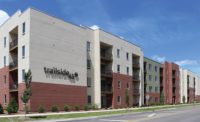In the process of achieving LEED Gold, Sangren Hall is Western Michigan University’s (WMU) new $60 million facility and the result of years of campaigning, fundraising and planning. Replacing the original Sangren Hall completed in 1964, the new Sangren hall is situated on more than eight acres in the center of campus. It houses the College of Education and Human Development, and the Department of Sociology. With 30 percent more seats than the former facility, the new building is expected to carry on the original Sangren Hall’s legacy as one of the university’s most heavily utilized classroom buildings. In fact, the university predicts that nearly every student who graduates with a four-year degree from WMU will have had at least one class in this building.
Inside the 230,000-square-foot, four-story facility are 50 classrooms with 2,435 instructional seats, two 200-seat auditoriums, an education library, a grants and research center, and an office and clinical space for programs including the Center for Counseling and Psychological Services, the Kercher Center for Social Research, and the Dorothy J. McGinnis Reading Center and Clinic.
Part of the New Core
Although the university originally intended to renovate the existing Sangren Hall, WMU officials quickly recognized that the building’s constraints would not allow for the outcomes they wanted from the project. A central factor in this decision was the university’s desire to ensure that the facility supported its campus master plan on a number of levels.
A main component of the master plan was the university’s desire to create a centralized area by converting Michigan Avenue from a parking lot into a pedestrian mall. Working with the plans for the campus mall, which was completed simultaneously, the architects at SHW Group designed the new Sangren Hall to act as a physical boundary for the mall, creating a strong edge and reinforcing the mall concept. A two-story promenade on the first floor parallels the mall and is the location for a number of multipurpose classrooms and lecture rooms for campus-wide use, allowing students from a variety of academic focuses to enjoy views overlooking the new mall.
As a central, heavily utilized building, access was another important factor to university planners. As such, the building is nestled into a hillside to allow for access at different levels and from different directions.
A Modern Learning Environment
The building is designed to meet the needs of 21st century students while accommodating a wide variety of learning styles. For this reason, a variety of spaces—from small classrooms, to large auditoriums, to breakout areas—are incorporated throughout the building. In addition, specialized rooms, such as model K-12 classrooms with attached observation rooms, are incorporated to meet the needs of the College of Education students.
In initial conversations, the university expressed a desire for the new Sangren Hall to serve as the central social hub for the College of Education program. In response, the architects designed the heart of the building to be a second floor cafe area overlooking a double-height space and adjacent to the library and College of Education’s dean’s office. This space serves as the heart of the College of Education, providing students with a place to socialize or study.
|
Architect: SHW Group
|
The design takes collaborative space to a new level by incorporating flexible elements throughout the project and integrating opportunities for informal learning into the building circulation. Collaborative learning spaces are situated outside of every classroom, and banquette seating featuring embedded technology is placed throughout the facility. In addition, all corridors incorporate a playful notion of seating with both small and large configurations for group and individual study. For students who prefer a quieter environment, enclosed rooms located on the first and fourth floors can be utilized by small groups or for individual study. In addition, classrooms and auditoriums feature highly efficient and flexible configurations that allow students and teachers to adjust the room based on its users needs.
The building is also designed to accommodate the technology needs of 21st-century students. A dedicated media lab features a large screen where students can plug in personal devices like laptops to display presentations to the entire class. Furthermore, separate meeting rooms for small group study in the library also feature screens to display presentations.
Sustainability
Sangren Hall is impressive from an environmental standpoint as well. Designed to achieve LEED Gold certification, the building is expected to save $345,000 annually on energy costs over the old Sangren Hall. Furthermore, compared to the ASHRAE standard building, Sangren Hall uses 30 to 35 percent less energy and 50 percent less water.
In addition, a photovoltaic panel array on the roof will provide a portion of the electricity used by the building. The array is a fixed-tilt, self-ballasted system with a centralized inverter strategy. The 230,000-watt array consists of 975 solar panels and can generate up to 253,000 kWh annually.
Meeting Campus Initiatives
Key to the design of Sangren Hall was the collaboration by all parties throughout design and construction. Its architects developed a design based not only on the university’s expressed needs, but also by careful interpretation of the campus master plan. This plan provided SHW Group clear goals on which to make design decisions. Positioning the building as the heart of campus, allowing access at both the first and second levels, and incorporating sustainable design features are just some of the goals that were outlined by the university.







Report Abusive Comment